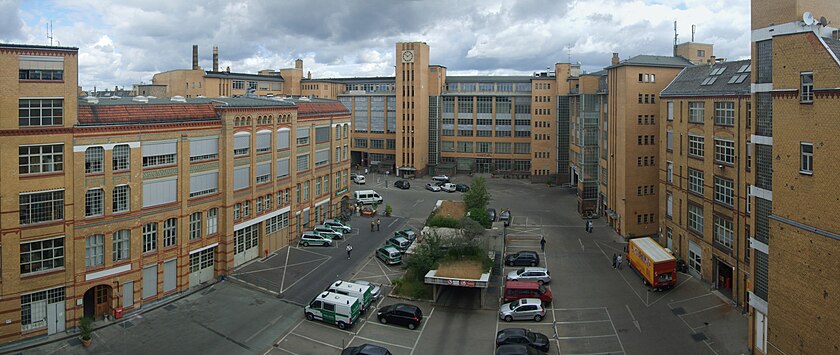Richard Shirop
Johann Hermann Richard Schirop (born September 30, 1852 in Berlin ; † December 23, 1916 there ) was a German architect . His creative focus was on industrial buildings.
Life
After training as a carpenter and graduated with a master to study about 1880 Schirop at the Technical College of Charlottenburg (today Technical University of Berlin ) architecture . He was married to Anna Dorothea Köhler in his first marriage from 1878 until her death in 1882. In his second marriage he married Maria Habisch in 1886 and initially lived with his in-laws at Grünauer Strasse 13, Berlin SO. Then the Schirops moved to Berlin-Kreuzberg (SO 36), Reichenberger Straße 128. As a freelance architect, he managed to get several orders for the construction of larger factories at the beginning of the 20th century.
Buildings by Richard Schirop (selection)
AEG Hydrawerk
The first factories were built on the area between Drontheimer Straße 30-38 and Tromsöer Straße at the beginning of the 20th century. On behalf of Elektrizitäts AG Hydrawerk , which produced capacitors there , Richard Schirop expanded the buildings by a factory for rubber production by 1909 . For this he had planned a clinker brick building on four floors. A stair tower in front of the building as well as the sparingly used building decorations by plastered panels in the parapet surface and smoothly incorporated lattice windows were striking. Hydrawerk AG became a wholly-owned subsidiary of AEG in 1925, and after 1945 they had another floor set up, which jumps back a little, and an iron lattice tower for the freight elevator. The building ensemble has been preserved in this form and is now a listed building. However, nothing is produced here anymore, but the former "AEG Hydrawerk" serves as an office building. The rubber factory described here was joined by an administration building based on plans by Julius Lichtenstein in 1921 and another production facility designed by Ernst Ziesel in 1928/1929 .
Osramhöfe
On an area between See , Oudenarder, Liebenwalder, Groninger and Malplaquetstrasse in Berlin-Wedding, construction began in 1904 for the new Bergmann Electricitäts-Werke AG factory . The company founded by Sigmund Bergmann wanted to manufacture "Bergmann metal filament lamps" there. The construction plans for the five-story building came from the architect Hermann Enders . As early as 1910 there was a daily output of 10,000 lamps. The parallelism of building and producing was possible because the incandescent lamp factory consists of “storey factories” that were built in different construction phases between 1904 and 1910. From 1905, extensions were added, which were planned and implemented by Richard Schirop (Building 32, completed in 1910) and by the government master builder Waldemar Pattri (1920 and 1937). Between 1912 and 1914 Bergmann also had an administration and laboratory building (building 31) designed by Schirop built.
The site and all of the buildings on it came into the ownership of Osram between 1932 and 1935 , which continued to produce lamps and market them worldwide.
After production was discontinued around 1990, the facilities known as "OsramHöfe" were given the status of monument protection by the State of Berlin and "Carrée Seestrasse GbR" took over the buildings. The management was initially with the trust real estate company, then they fell to the real estate company Engel & Völkers .
Doctors, part of the Technical University of Applied Sciences Berlin (Forum der Beuth University), institutes and retailers then rented the reconstructed and technically upgraded buildings . The top floor with a usable area of around 1000 square meters is still empty.

Web links
- Gerhild HM Komander: The Wedding - On the way from red to colored . Berlin Story Verlag, 2006, ISBN 3-929829-38-X ( books.google.de [accessed on March 1, 2013] The second architect named in the book, Walter Petri, is not included in the address books of the years ahead, however is found W. Pattri, Government Builder (1890)).
- Stefan Örtel: Dr. Carl Freiherr Auer von Welsbach and the history of Auergesellschaft and OSRAM, Berlin. on pressed glass correspondence, 2008.
Individual evidence
- ^ Standesamt Berlin V b, death register no. 972/1916. State Archives Berlin.
- ↑ Shirop, Richard; Architect u. Carpenter . In: Berliner Adreßbuch , 1910, III, p. 2454.
- ↑ Monument rubber factory of the AEG-Hydrawerk, Drontheimer Straße 30A / B, 34 / 34A, 36, 38; 1909 by Richard Schirop
- ↑ Pattri, W., Government Builder . In: Berliner Adreßbuch , 1890, part 1, p. 898 (SW, Ritterstrasse 41).
- ↑ Press information about the Osramhöfe. Accessed December 2012 .
- ↑ Osramhöfe architectural monument complex
- ↑ Brief information from the Beuth-HS on the Osramhöfe forum. Retrieved March 1, 2013 .
- ↑ A little history about the Osramhöfe. (No longer available online.) Formerly in the original ; Retrieved on March 1, 2013 (website Engel & Völkers real estate company, which markets the Osramhöfe complex in the 21st century). ( Page no longer available , search in web archives ) Info: The link was automatically marked as defective. Please check the link according to the instructions and then remove this notice.
| personal data | |
|---|---|
| SURNAME | Shirop, Richard |
| BRIEF DESCRIPTION | German architect |
| DATE OF BIRTH | September 30, 1852 |
| PLACE OF BIRTH | Berlin |
| DATE OF DEATH | December 23, 1916 |
| Place of death | Berlin |